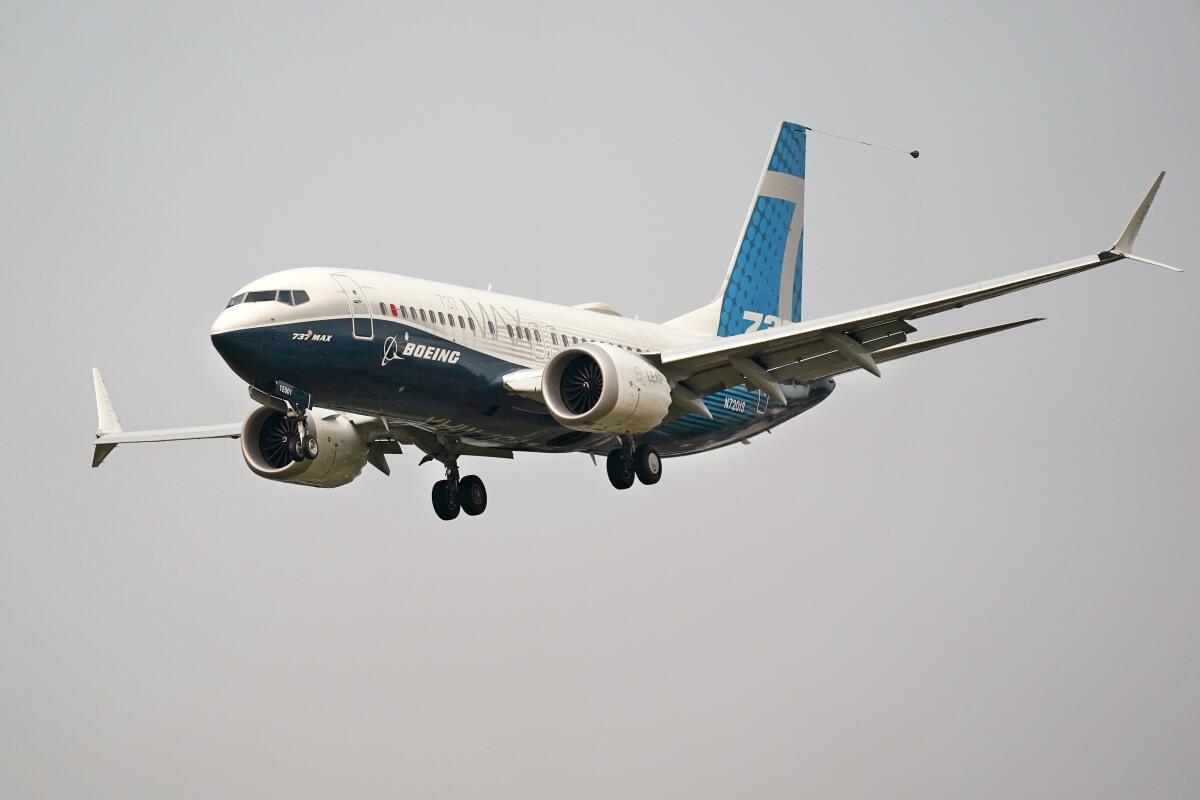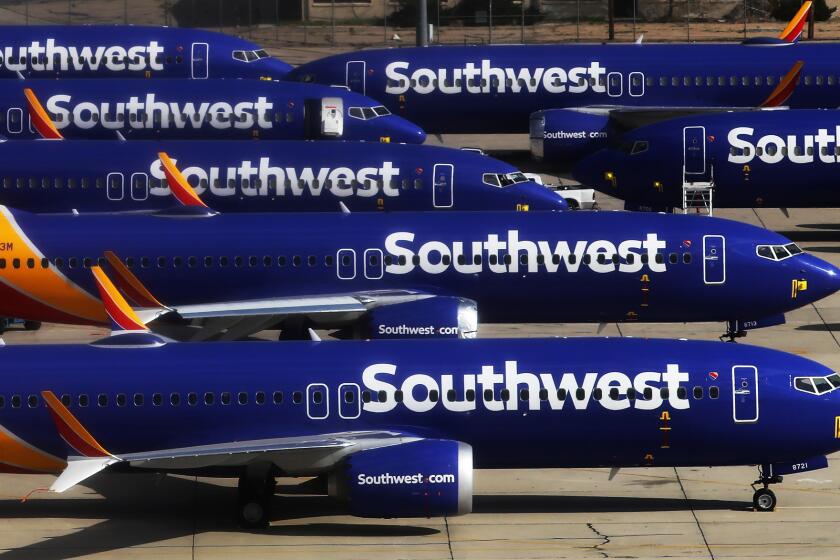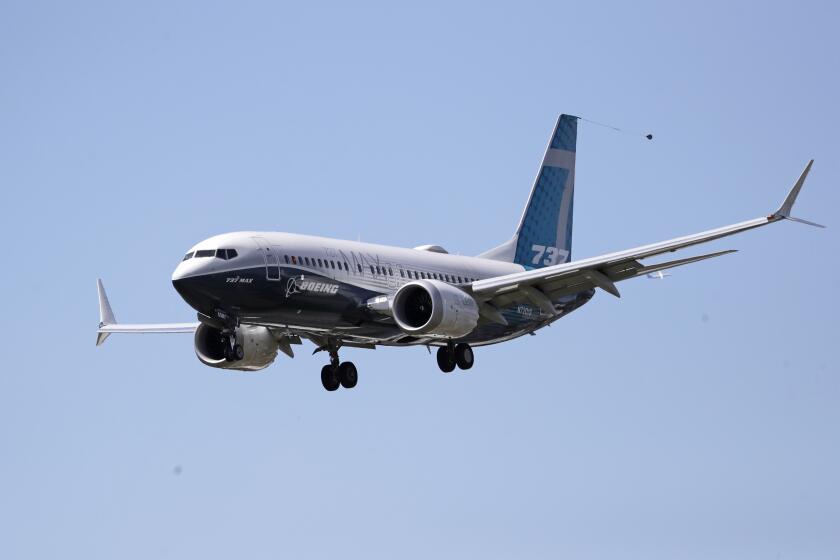FAA clears Boeing 737 Max to fly again

- Share via
Nearly two years after a pair of deadly crashes, the U.S. Federal Aviation Administration has cleared Boeing’s 737 Max for flight.
The nation’s air safety agency announced the move Wednesday, saying it made the decision after a “comprehensive and methodical” 20-month review process.
Regulators around the world grounded the Max in March 2019 after the crash of an Ethiopian Airlines jet. That happened less than five months after a Max flown by Indonesia’s Lion Air plunged into the Java Sea. A total of 346 passengers and crew members on the planes were killed.
FAA Administrator Stephen Dickson signed an order Wednesday rescinding the grounding. U.S. airlines will fly the Max once Boeing updates crucial software and computers, and pilots receive training in flight simulators.
The FAA says the order was made in cooperation with air safety regulators worldwide.
The move follows exhaustive congressional hearings on the crashes that led to criticism of the FAA over alleged lax oversight and Boeing, which was accused of rushing to implement a new software system that put profit over safety and ultimately led to the firing of the company’s chief executive.
Investigators focused on anti-stall software that Boeing had devised to counter the plane’s tendency to tilt nose-up because of the size and placement of the engines. That software pushed the nose down repeatedly on both planes that crashed, overcoming the pilots’ struggles to regain control. In each case, a single faulty sensor triggered the nose-down pitch.
The new software now requires inputs from two sensors to activate the software, which Boeing says does not override pilot controls like it did in the past.
Airlines have begun to strategize on how to get anxious fliers back into the cabin of a Boeing 737 Max, but it won’t be easy.
The company changed the software so it doesn’t repeatedly point the nose of the plane down to prevent possible aerodynamic stalling.
On a conference call with reporters, Dickson said the Max is now the most scrutinized transport aircraft in history, with more than 40 FAA employees working tens of thousands of hours on the plane.
“The design changes we have overseen make it impossible for these accident scenarios to reoccur,” he said.
He said that if FAA had known after the Lion Air crash what it learned during this review of the plane, it should have grounded the plane after the first crash.
“These events and the lessons we have learned as a result have reshaped our company and further focused our attention on our core values of safety, quality and integrity,” Boeing Chief Executive David Calhoun said in a statement.
The good news for Boeing comes in the middle of a pandemic that has scared away passengers and decimated the aviation industry, limiting its ability to make a comeback. Air travel in the U.S. is down about 65% from a year ago.
Boeing‘s sales of new planes have plunged because of the Max and the COVID-19 pandemic. Orders for more than 1,000 Max jets have been canceled or removed from Boeing’s backlog this year. Each plane has a sticker price of $99 million to $135 million, although airlines routinely pay less.
Low-cost carrier Norwegian Air Shuttle says it has canceled its 97 orders for planes from Boeing, including scores of the controversial 737 Max model.
Boeing stock fell 3.2% on Wednesday to $203.30 a share. That’s less than half the all-time high of $440.62 reached March 1, 2019, days before the Ethiopian crash, but it’s well above the $95 trough this March, when the pandemic caused massive disruptions to travel and the global economy.
John Hansman, an aeronautics professor at MIT, said people typically avoid airplanes for a few months after there are problems. But the Max case is unusual, and were it not for COVID-19, Hansman said, he would feel safe flying on a Max.
“It’s probably the safest airplane to be on,” he said.
Relatives of people who died in the crashes aren’t convinced. They accused Boeing of hiding crucial design features from the FAA.
“The flying public should avoid the Max,” said Michael Stumo, whose 24-year-old daughter died in the second crash. “Change your flight. This is still a more dangerous aircraft than other modern planes.”
American Airlines is the only U.S. airline to put the Max in its schedule so far, starting with one round trip daily between New York and Miami beginning Dec. 29. United expects to start using the plane early next year, and Southwest said its Max jets won’t fly before the second quarter of 2021.
Some consumer groups urged airlines to fully disclose when Max flights are planned. That information is usually on an airline’s website, although passengers have to know where to click. Advocates are concerned about airlines using the Max in a last-minute switch.
Nearly 400 Max jets were in service worldwide when they were grounded, and Boeing has built and stored about 450 since then. All have to undergo maintenance before they can fly.
Also, pilots must undergo simulator training, which was not required when the aircraft was introduced. Hansman said training for qualified 737 pilots shouldn’t take long because Boeing has fixed software problems.
Boeing’s reputation has taken a beating since the crashes. Its then-CEO, Dennis Muilenburg, initially suggested that the pilots were to blame for the accidents. However, congressional investigators discovered an FAA analysis — conducted after the first Max crash — that predicted there would be 15 more crashes during the plane’s lifespan if the flight-control software were not fixed.
Boeing was repeatedly wrong about how quickly it could fix the plane. When those predictions continued to be wrong, and Boeing was perceived as putting undue pressure on the FAA, Muilenburg was fired in December 2019.
After an 18-month investigation, the House Transportation Committee heaped blame on Boeing, which was under pressure to develop the Max to compete with a plane from European rival Airbus, and on the FAA, which certified the Max and was the last agency in the world to ground it after the crashes. The investigators said Boeing suffered from a “culture of concealment” and pressured engineers to rush the plane to the market.
A government watchdog says Boeing failed to give regulators documents about changes it made in a key system blamed in two crashes of its 737 Max jet.
Among the criticisms was the FAA’s use of Boeing employees to inspect and evaluate the Max, with some workers feeling pressured by the company to act in its favor.
Dickson said the so-called designee program has changed, with the FAA handling all evaluations of the Max itself. FAA inspectors will check every new Max before it’s cleared for flight, he said.
The designee program will continue on future aircraft, he said, but the agency is “implementing various measures to make sure there’s a free flow of communication and data between manufacturers and the FAA.”
Dickson — a former Air Force and Delta Air Lines pilot — flew the Max personally before it was cleared.
Europe’s aviation regulator, the European Union Aviation Safety Agency, said it will take public comment on plans to clear the Max for flight and expects to finalize a plan by early next year. Some EU member states will have to lift their own grounding notices as well. Regulators in Canada and China are still doing their own reviews.
Relatives of crash victims say it’s too soon for the Max to fly again, and they and their lawyers say Boeing and the FAA are withholding documents.
“The cases from the incidents are not 100% finished yet,” said Anton Sahadi, who lives in Jakarta, Indonesia, and lost two brothers in the Lion Air crash. “I think all the victims’ family in Indonesia and Ethiopia will feel the same, so regretful, why it can fly again because we are still in the recovery process for our problems because of the incidents.”
Naoise Ryan, an Irish citizen whose husband died in the Ethiopian crash, said the Max is “the same airplane that crashed not once but twice because safety was not a priority for this company.”
Koenig and Krisher write for the Associated Press.
More to Read
Inside the business of entertainment
The Wide Shot brings you news, analysis and insights on everything from streaming wars to production — and what it all means for the future.
You may occasionally receive promotional content from the Los Angeles Times.













